Dumbbells are one of the most affordable ways to work out at home. But is a dumbbell-only home gym enough to build muscle?
Generally speaking, a dumbbell-only home gym is effective at building muscle. However, it is essential to choose suitable dumbbells. The best dumbbells for gaining muscle at home should be both heavy as well as offer small weight increments for efficient progressive overload.
I used dumbbells to help me gain over 20lbs of muscle so I know you can do it too.
In this article, I’ll be sharing the dumbbells I used to achieve this, and how to use those dumbbells in a training program to build muscle at home.
I’ll also reveal 2 other bits of cost-effective equipment to supercharge your training results.
Let’s dive in.
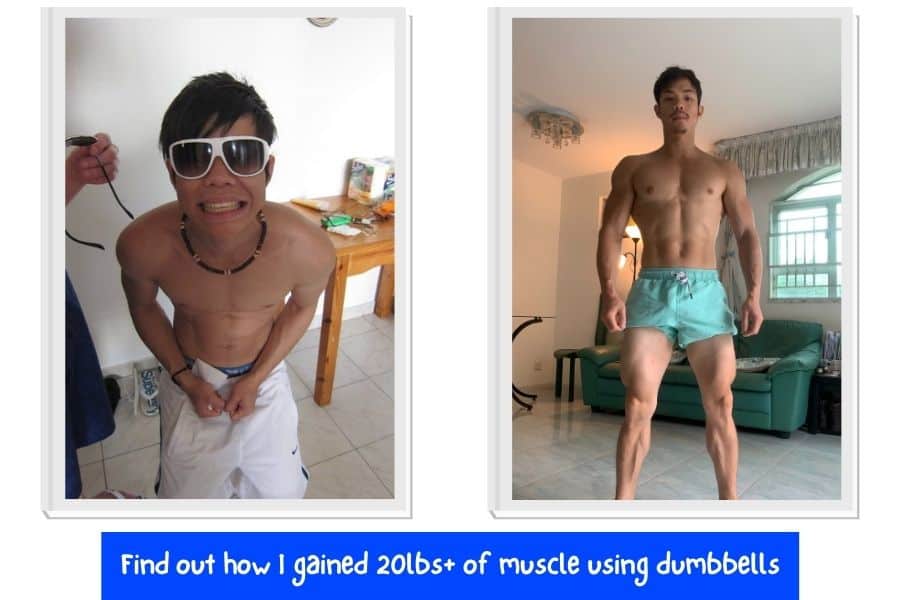
Building A Dumbbell-Only Home Gym
Here’s everything you’ll need to build a dumbbell-only home gym:
- Heavy selectorized dumbbells (essential).
- Adjustable weight bench (highly recommended).
- Power tower (optional).
- Protein powder (highly recommended)
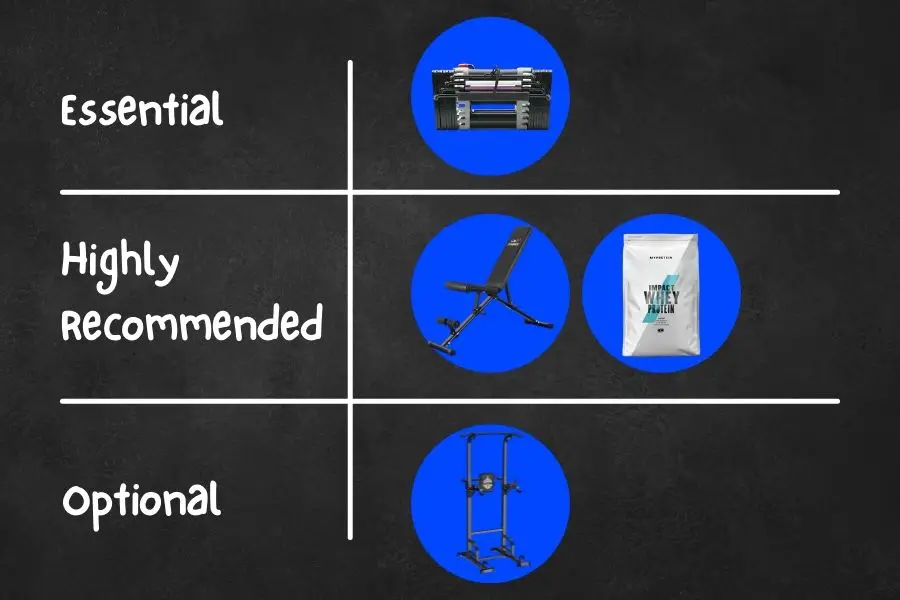
Dumbbells are essential and the focus of this article. I would recommend getting 70lb selectorized dumbbells at the very least for men looking to build muscle. This will future-proof your dumbbells and minimize the need to upgrade further down the line which can be a waste of time and money.
A weight bench is unessential but highly recommended. It’s an extremely cost-effective way to unlock the full potential of your dumbbell chest, abdominal, and back exercises.
Similarly, a power tower is optional. It will allow you to do dumbbell-weighted chest dips and pull-ups (two extremely powerful upper body exercises to fast-track your journey to a v-taper).
Protein powder is also highly recommended. Remember that training is just half the muscle-gain journey. You’ll also need to consume at least 1g of protein and a 5-15% caloric surplus every day to fuel the muscle-building process. And if you lead a busy lifestyle or have a naturally low appetite, protein shakes can help a lot with hitting your nutrition targets,
None of this gear has to break the bank or take up too much space if you pick the right brands and models (see next).
Equipment Recommendations For A Dumbbell-Only Home Gym
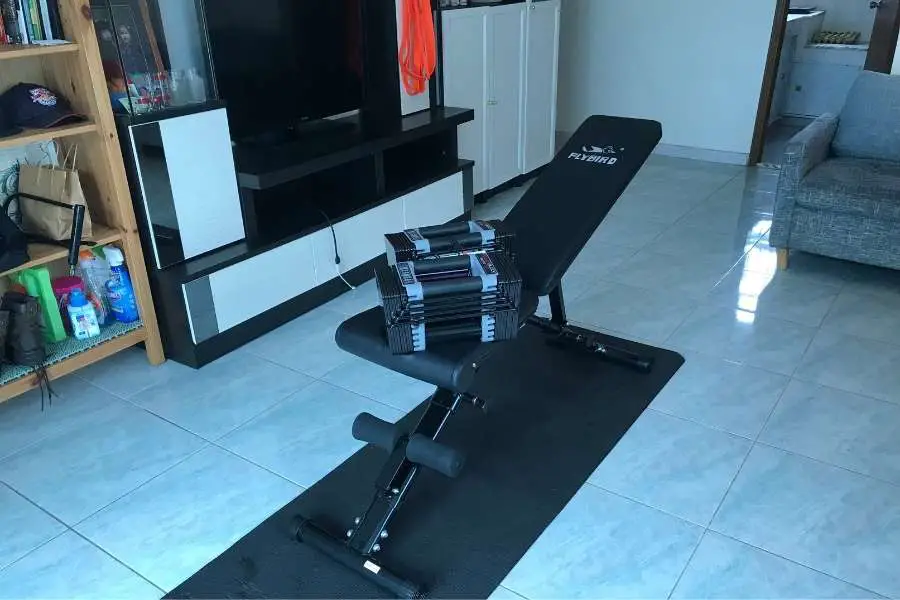
Disclaimer: not all of these recommendations are the absolute best on the market. Rather, they’re what I feel offers the greatest value for money to build an effective dumbbell-only home gym. They’re the items I use and recommend to friends and family.
Here’s the equipment I recommend for a dumbbell only home gym:
| Product | Brand | Description | Prime | Buy |
|---|---|---|---|---|
Top Top
Top
Top Top
Top
Top | PowerBlock | BEST dumbbell for a dumbbell-only home gym. Fully adjustable from 5-90lbs (with add-on kits). But expensive. | PrimeEligible | Check Amazon Price |
 | Yes4All | BUDGET dumbbell alternative for a dumbbell-only home gym. Affordable and durable but has much fewer weight increments than PowerBlocks. | PrimeEligible | Check Amazon Price |
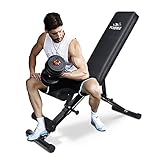 Top
Top
Top Top
Top
Top | Flybird | OPTIONAL. Fully-adjustable flat/incline/decline weight bench for bench press and flyes. Can be folded and stowed away after a workout. | PrimeEligible | Check Amazon Price |
 | Sports Royals | OPTIONAL. Pull-up and dip station to complement your dumbbells. Will help build a bigger upper body. | PrimeEligible | Check Amazon Price |
 Top
Top
Top Top
Top
Top | MyProtein | OPTIONAL. Low-calorie whey powder containing 21g of protein per serving. Ideal for lean muscle gains. | PrimeEligible | Check Amazon Price |
1) Selectorized dumbbells- Powerblock Elites ($320)
The 2 most important things you should take into account when buying dumbbells for muscle-building are:
- They should be heavy enough to challenge your muscles now and into the future.
- They should have small weight increments to allow smooth progressive overload.
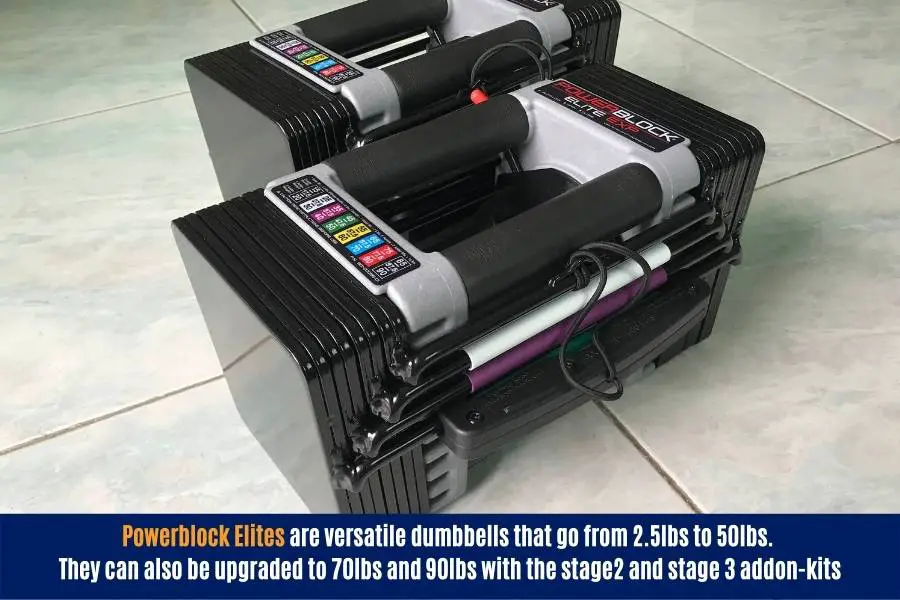
The Powerblock Elite series (link for cheapest price) fit both criteria perfectly.
The base model weighs 50lbs per dumbbell with the option to upgrade to 70lbs and 90lbs using the stage 2 and stage 3 addon’s whenever you wish.
This means that should you wish, you can get the 50-pounders first, then upgrade with the addon kits whenever you’re ready (rather than forking out 500+ bucks from the get-go).
You can find my hands-on review of the PowerBlock Elites here.
Here’s a guideline for which weight option to choose as a first-time buyer:
| < 1 month training exp | 2-12 months training exp | 12+ months training exp | |
| 100-160lb bodyweight | 50lb | 70lb | 70lb |
| 170-220lb body weight | 70lb | 70lb | 90lb |
| 220lb+ bodyweight | 90lb | 90lb | 90lb |
Each dumbbell features small 2.5/5lbs adjustments.
They also come with a 5-year warranty which is one of the best on the market.
Being selectorized dumbbells, they also replace up to 28 pairs of fixed-weight dumbbells (which would cost you well over $1k). And this saves you space as well as money.
They’re comfortable to use, the weight adjustment mechanism is slick, and the powder-coated steel components make them physically hard-wearing.
The reviews are 95% positive and their customer support is industry renowned.
- SINGLE DUMBBELL 52.5 LBS TOTAL: ONE 16”x1.15” handle, EIGHT 5-pound plates, TWO 2.5-pound plates, TWO 1.25-pound plates, TWO collars
- CAST IRON WEIGHT PLATES FIT 1.15-INCH STANDARD BAR: Accommodate all standard 1.15-inch handles. Durable cast iron plates covered with black paint finish preventing rust and corrosion for lifetime use
- 14-INCH DIAMOND KNURLED CHROME HANDLE: Constructed of high-quality, textured chrome handle for secure, firm, and non-slip grip
- STAR-LOCK COLLARS WITH LOOSE-RESISTANT RUBBER TRIMS AND SCREWS: Threaded ends with star-lock collars provide a safe, secure workout & easy weight plate changes.
- EASY USE & STORAGE: Take seconds to assemble and take out. Compact, convenient, and easy to use and store. All-for-one dumbbells eliminate the need for multiple dumbbells in your workout space. Suitable for performing basic toning body workouts, core fitness, strength exercises and heavy leg lifts
If you don’t have 300 bucks to spend, then the Yes4All spinlock dumbbells (check link for cheapest price) make a great budget option. But just be aware that the weight increments are quite large.

If this is your first time weight training, you may also be interested in getting a pair of gloves to protect your hands from callouses.
Gloves don’t have to be expensive to be effective.
I use the Ihuan ventilated neoprene gym gloves (link for cheapest price).
2) Weight bench- Flybird FB149 adjustable bench.
Although a weight bench isn’t essential for a dumbbell home gym, trust me when I say that it can ramp up your training results from 70% to 90%.
Honestly, a bench unlocks so many upper body benefits when it comes to home dumbbell training.
And a good bench doesn’t have to be expensive either.
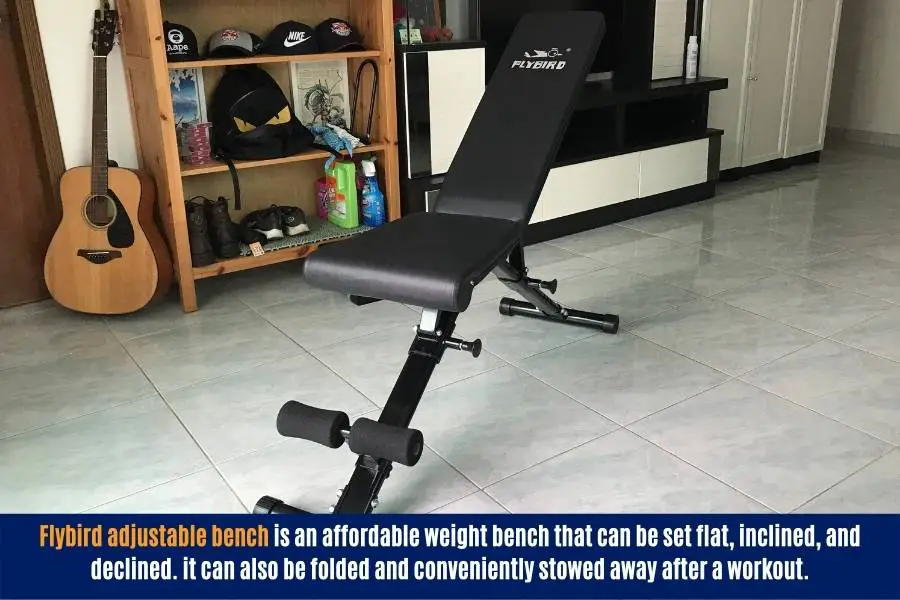
The Flybird FB149 adjustable weight bench (link for cheapest price) makes the perfect partner for the Powerblocks.
It’s extremely affordable, has all the angle adjustments you would need, and the 700-lb weight capacity is more than enough for dumbbell workouts.
My favorite feature is the folding function (you can go here to check out my hands-on review for the Flybird adjustable bench).
After you’re workout, you can fold it and stow it away where you like. And this is a Godsend for busy shared households or small apartments.
If you’re outside of 5’6″-6’0″, then the Fitness Reality adjustable weight bench is equally good and provides a more comfortable lifting experience for your height.
You might also be interested in my other article to learn more about the best weight benches for dumbbells.
3) Power tower- Sports Royals tower.
A power tower is not essential for a dumbbell-only home gym but makes a very welcome addition.
I only recommend getting a power tower if you have a couple of hundred bucks and 9 square feet of floor space to spare.
It’s used mainly for chest dips and pull-ups (two powerful upper-body compound exercises). These two exercises will complete your dumbbell program.
It can also be used for hanging leg raises which are great for targetting the notoriously hard-to-develop lower abs.
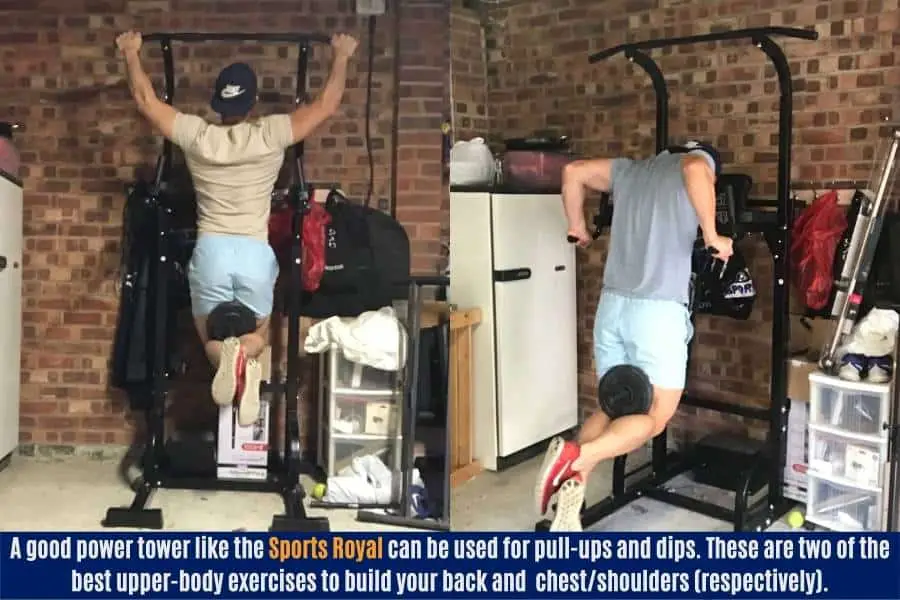
I use and recommend the Sports Royal Power Tower (link for cheapest price).
It’s relatively cheap for a good tower, stable, easy to assemble, and can accommodate pretty much all user heights.
You can hold a dumbbell between your legs for weighted dips and pull-ups.
This doesn’t work so great with Powerblocks due to their block shape. You’ll need a chained weight belt.
The DMoose belt is cheap and does the job very well.
4) Protein powder- MyProtein Impact Whey and Creatine Monohydrate.
From my experience, the best protein powders are delicious, easy to mix and drink, and are “clean” (meaning they’re not adulterated with fats, sugars, and additives).
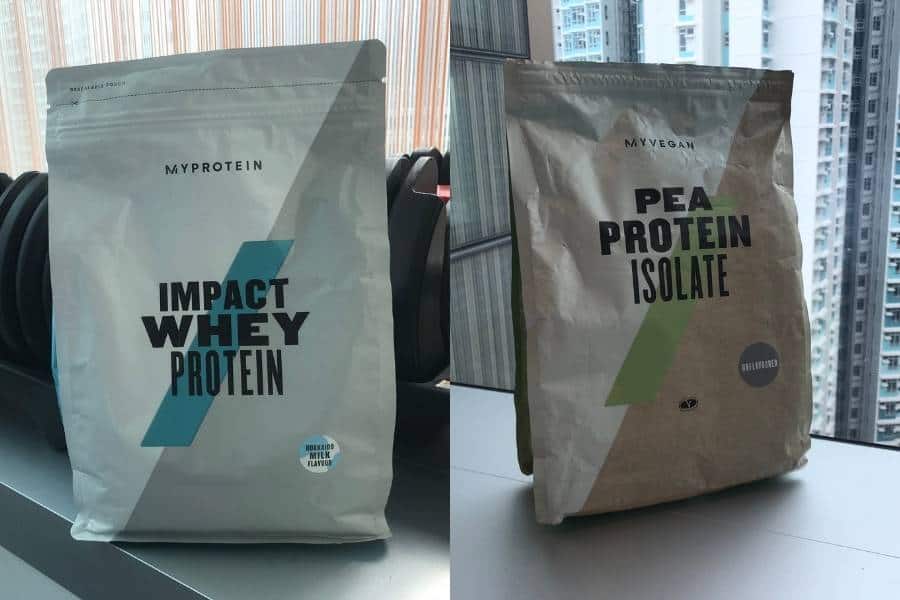
The MyProtein Impact Whey (link for cheapest price) is exactly that.
Each scoop contains 21g of protein and 100 calories, making it awesome for making lean muscle gains with minimal fat. I usually have a shake in the morning and immediately after a workout.
Plant-eaters can use the MyVegan Pea Protein instead.
If you’re a skinny guy looking to put on weight fast, then the Optimum Nutrition Serious Mass may be a better option.
It’s slightly more expensive per serving, but you’ll get 50g of protein and 1250 calories.
I also like to add a scoop of MyProtein Creatine Monohydrate to help me train harder.
Creatine is found naturally in all our muscles at low concentrations, where it helps with energy utilization.
The supplement simply tops up our creatine levels.
3-Day Dumbbell Full Body Home Workout Routine
Here’s a 3-day beginner dumbbell workout I used to help me gain over 20lbs of muscle. I’m sure it will also work for you too!
Ultimately, all you need for this program are dumbbells, but the recommended additional gear mentioned above will help a lot on your journey to build muscle.
Program Overview:
The program revolves around compound dumbbell and bodyweight exercises supplemented with isolation-type movements.
From my experience, this is the best way to drive full-body muscle growth as well as build definition in areas like the arms, back, chest, shoulders, and abs.
As a beginner, you’ll be completing 3 training days per week. Each training day consists of a full-body workout.
Each workout takes around 45-75 minutes to complete, depending on your rest times.
It’s not important which days you choose to train (down to your personal preference).
But what is important is completing your 3 days per week and ideally having a rest day in between each training day.
Day 1:
| Dumbbell Exercise | Target Muscle | Reps | Sets | Extra equipment req. |
|---|---|---|---|---|
| Dumbbell deadlift | Legs | 6-15 | 3 | N/A |
| Flat dumbbell bench press | Chest | 6-10 | 3 | Adjustable weight bench |
| Bent-over dumbbell row | Back | 6-10 | 3 | N/A |
| Seated dumbbell shoulder press | Shoulders | 6-10 | 3 | Adjustable weight bench |
| Dumbbell-weighted decline sit-up | Abdominals | 8-15 | 3 | Adjustable weight bench |
| Dumbbell bicep curls | Arms | 8-15 | 3 | N/A |
Note: if you don’t have a weight bench you can substitute the dumbbell bench press, seated shoulder press, and decline sit-up with a dumbbell floor press, shoulder press on a chair, and weighted crunch (respectively).
You might also be interested in my other article for DIY flat bench alternatives.
Day 2:
| Dumbbell Exercise | Target Muscle | Reps | Sets | Extra equipment req. |
|---|---|---|---|---|
| Goblet squat with dumbbells | Legs | 6-15 | 3 | N/A |
| Dumbbell-weighted chest dips | Chest | 6-10 | 3 | Power tower and belt |
| Upright row | Back | 6-10 | 3 | N/A |
| Chest supported incline reverse fly | Shoulders | 8-15 | 3 | Adjustable weight bench |
| Dumbbell side-bends. | Abdominals | 8-15 | 3 | N/A |
| Overhead tricep extensions. | Arms | 8-15 | 3 | N/A |
Note: if you don’t have a power tower you can substitute the chest dip with a dumbbell floor press. And if you don’t have a weight bench you can substitute the incline reverse fly with a standing reverse fly (a bench leads to greater shoulder muscle activation though).
Day 3:
| Dumbbell Exercise | Target Muscle | Reps | Sets | Extra equipment req. |
|---|---|---|---|---|
| Dumbbell lunges | Legs | 6-10 | 3 | N/A |
| Incline dumbbell bench press | Chest | 6-10 | 3 | Adjustable weight bench |
| Dumbbell-weighted pull-ups | Back | 6-10 | 3 | Power tower and belt |
| Lateral raise with dumbbells | Shoulders | 8-15 | 3 | N/A |
| Hanging leg raise with dumbbells | Abdominals | 8-15 | 3 | Power tower |
| Bicep curl or bicep extension | Arms | 8-15 | 3 | N/A |
Note: if you don’t have a weight bench you can substitute the incline dumbbell press with a standing dumbbell crossover. If you don’t have a power tower you can substitute the pull-up and leg raise with a single-arm row and weighted crunch (respectively).
You might also be interested in my other article for incline bench home alternatives!
Choosing the right dumbbell weight:
It’s important to use a dumbbell weight that’s heavy enough to challenge your muscles to grow, but not so heavy that you can’t complete all your sets.
The easiest way to do this is to just go with trial and error.
Use your first few weeks of training to gauge your strength level.
Start with a weight you know you can lift and then add more weight to determine how much weight fatigues you in 6-reps, 7-reps, etc.
By the end of the last rep of the last set, you should reach near-failure (not complete failure).
This is the sweet spot to aim for.
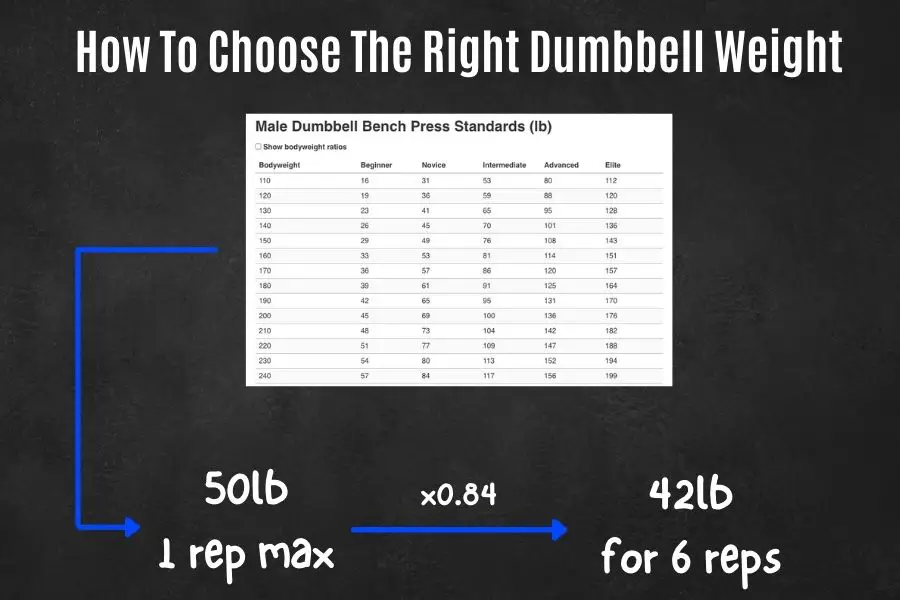
You can also use the Strength Levels database to give you a rough idea of how much weight you should be lifting based on your current bodyweight and training level.
Just note that these numbers are for a 1-rep max (1RM).
To convert the 1RM into your working weight you can multiply the 1RM by the following:
- 6 reps: x0.84
- 7 reps: x0.82
- 8 reps: x0.80
- 9 reps: x0.78
- 10 reps: x0.73
- 11 reps: x0.69
- 12 reps: x0.64
- 13 reps: x0.60
- 14 reps: x0.56
- 15 reps: x0.52
Using a 50lb dumbbell bench press 1RM as an example:
Multiplying 50lb by 0.84 means you should aim to be lifting ~42lb for 6 reps.
You can go to my other post for more details on rep range percentages.
Reps and sets:
Each exercise involves doing 3 sets. This provides a good balance between driving muscle growth and avoiding overtraining.
You’ll notice that the rep ranges seem quite large (between 6-15 reps per set).
Always start at the lower rep range and work yourself up as you build more strength. Once you reach the upper rep range limit, then you can increase weight and drop the reps again.
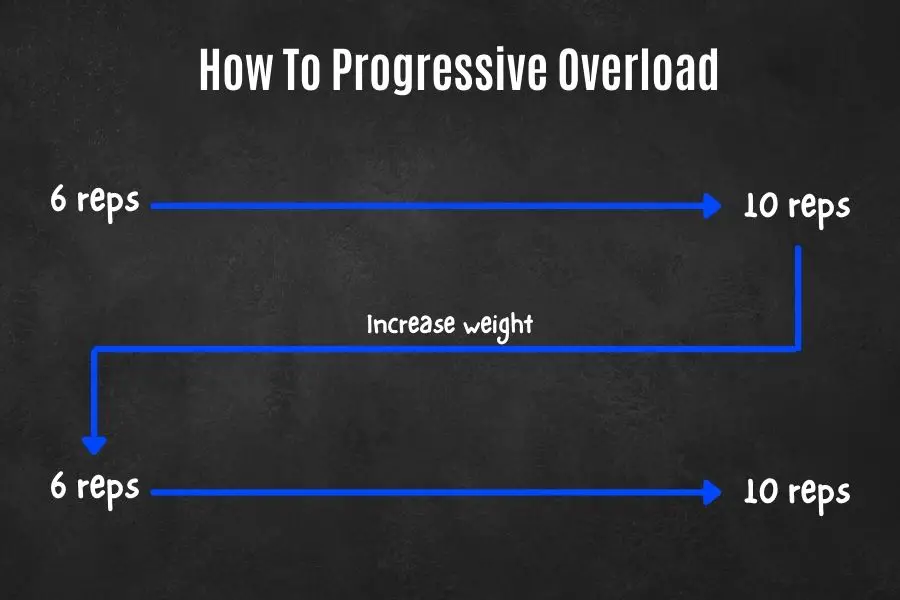
Using the dumbbell bench press as an example:
Try 6 reps in your first week and if can do this comfortably, then try 7 reps the next week, 8 reps the week after that, and so on.
Once you reach the 10-rep limit (rep limit will be different for each exercise as seen in the workout program), then you can add weight to each dumbbell and drop back down to 6 reps.
The aim is to keep each set challenging, and slowly but gradually build your strength.
Progressive overloading:
As you continue to get stronger, you’ll need to progressive overload to keep building more muscle.
This involves increasing reps until you’ve reached the upper rep limit for that given exercise (as explained above).
At this point, you can add weight to your dumbbells.
How much weight should you add?
As a general rule, I add 10% weight for the big compound exercises (bench press, shoulder press, row, pull-up, deadlift, squat) and 5% for the small isolation exercises (bicep curls, tricep extensions, sit-ups, lateral raises).
But this isn’t a strict rule you need to adhere to.
Best practice involves adding just about enough weight to take you back down to the lower rep range.
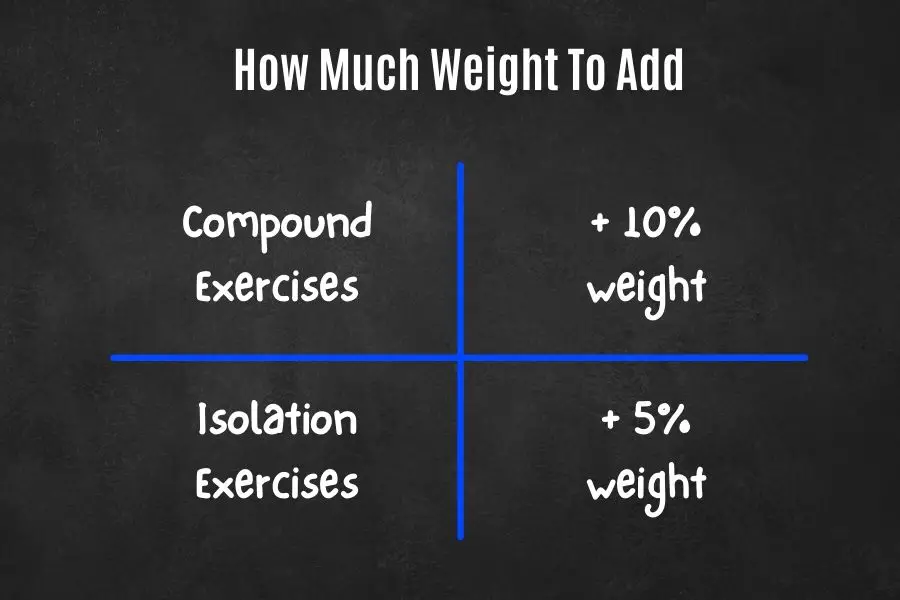
Using the dumbbell bench press as an example:
When you can perform 10 reps at 50lbs per dumbbell with good form, you can add 10% to each dumbbell. Now you should be able to do 6 reps at 55lbs per dumbbell and begin working back up to 10 reps again.
You can also check out my other post for an in-depth guide on how and when to increase dumbbell weight.
Form and technique:
Each rep should be performed slowly and with good form (ALWAYS).
This is especially important for dumbbell workouts where you need to make the most out of the limited weight you have access to.
A good target to aim for is to lift 1-2 seconds on the upward phase and 2-4 seconds on the downward phase. But slower is always better. The worst mistake you can make is to ego lift, meaning you sacrifice form for heavy weights.
The correct technique for all of the exercises in this program can be found on Youtube.
You can also check out my other article for a complete how-to for 36 of my favorite dumbbell exercises.
Rest time between sets:
Allow yourself 1-3 minutes rest between sets.
This should be enough time for your muscles to reach near-full recovery before doing the next set.

If you’re new to weight training, then stay closer to 3 minutes.
If you already have some experience, then go closer to 1 minute.
But ultimately everyone’s body is different so you should make a personal judgment.
The ideal rest duration gives your muscles enough time to complete another set, but not so long that you prolong your workouts unnecessarily.
Rest days between workouts:
Always give yourself at least 1 full day of rest between workouts.
This should give your body enough time for muscle recovery.
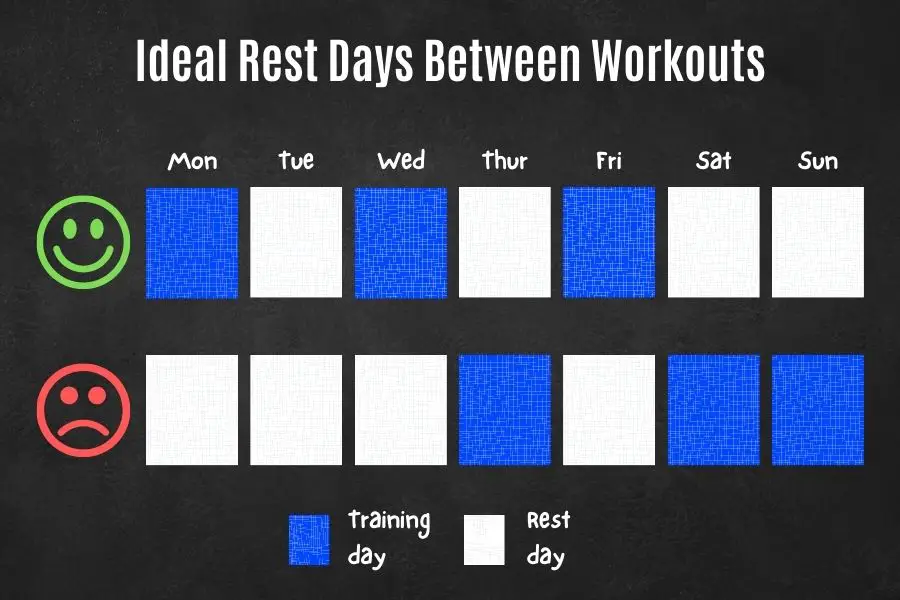
It’s ok for your muscles to still be slightly sore from the previous workout. This is to be expected for absolute beginners.
After a few weeks to a month of training though, this should begin to disappear as you become stronger and your muscles begin to adapt to your training.
Training should never be painful.
If it is, then you can try reducing the weight or reps.
Taking Things To The Next Level With A 5-Day Routine
After ~6 months of doing the 3-day routine, you may be ready for a 5-day routine.
You’ll know you’re ready for this when you’re able to fully recover from each workout without muscle soreness before the next workout begins.
Another good sign is if feel like you have the energy to add extra training days to the week.
When you’re ready, simply add two extra days from the 3 you’re already doing (do 4 days first before progressing to 5 days.
By this point, you should also be confident enough to start changing the program to target any muscles you feel are lagging (I recommend sticking to the same rep and set ranges)
Just make sure each workout hits all your muscle groups in a single training session.
You can also try this unique 5-day full-body dumbbell-only workout created by Fitness Vault if you want some variety.
Nutrition For Your Dumbbell Workouts
Remember, training is only half the battle when it comes to building muscle.
If you’re to build muscle from your dumbbell-only home gym, then you need to make sure you eat enough food.
This is essential.
I’ve always found 5 meals a day worked well for me.
Here are the macronutrient intakes that I used:
| Macronutrient | Daily Intake |
|---|---|
| Calories | 5-15% above maintenance calories |
| Protein | 1g per pound body weight |
| Carbs | 2.5g per pound body weight |
| Fat | 0.4g per pound body weight |
| Fiber | 1 portion fresh fruit/veg per meal |
Using The Dumbbell-Only Workout For Fat Burning
The same workout can be used effectively to burn fat.
All you have to do is adjust your calorie intake so that you are in a 5-10% daily deficit.
When you do this, your body will draw calories from body fat to fuel your workouts and the subsequent muscle repair process.
I would highly recommend keeping your protein intake the same though.
If you don’t eat enough protein, then your body will begin breaking down some of your hard-earned muscle during a caloric deficit!
FAQ’s
Are dumbbells enough for a home gym?
Generally speaking, dumbbells are sufficient for a home gym. They are versatile free weights that can be used to train the whole body. It is recommended to choose a dumbbell weight that is suitable to reach the desired training goal.
Check out my other article to find out the advantages and disadvantages of using dumbbells!
Are dumbbells and a bench enough to build muscle?
Using dumbbells and a weight bench is more than sufficient to build muscle. Combined, they will allow a person to target all the major muscle groups. An adjustable weight bench is recommended to isolate specific regions of a muscle group.
You can find out my dumbbell recommendations for beginners here.
What can I do instead of a bench press?
The bench press can be substituted by a floor press. This exercise targets the same muscle as the bench press. However, the floor press does not offer the same range of motion as the bench press. Therefore muscle activation will also be reduced.
What can I use instead of a gym bench?
Generally speaking, any flat, stable, and elevated platform can be used as a gym bench. Examples include a coffee table, a stack of books, and a couch armrest. An exercise ball or couch cushion can also be used as a homemade incline bench alternative.
Do I need a bench for home gym?
A weight bench is not essential for a home gym. However, a bench allows the user to perform a full variety of chest, ab, and back exercises. Therefore a bench is highly recommended for those looking to build muscle in the upper body.
Can you workout with just one dumbbell?
Generally speaking, all exercises can be performed with a single dumbbell. However, training with a single dumbbell will lead to longer workout durations and a severely reduced ability to lift heavy loads. Therefore buying two dumbbells is recommended where possible.
You may be interested in my other article to find out the benefits of using 2 dumbbells.
Do dumbbell exercises burn fat?
Generally speaking, dumbbell exercises are effective at burning fat. For this to occur, it is recommended to do full-body workouts and be in a daily 5-10% caloric deficit. The resulting calorie deficit will cause the body to burn calories from body fat.
Product Recap
| Product | Brand | Description | Prime | Buy |
|---|---|---|---|---|
Top Top
Top
Top Top
Top
Top | PowerBlock | BEST dumbbell for a dumbbell-only home gym. Fully adjustable from 5-90lbs (with add-on kits). But expensive. | PrimeEligible | Check Amazon Price |
 | Yes4All | BUDGET dumbbell alternative for a dumbbell-only home gym. Affordable and durable but has much fewer weight increments than PowerBlocks. | PrimeEligible | Check Amazon Price |
 Top
Top
Top Top
Top
Top | Flybird | OPTIONAL. Fully-adjustable flat/incline/decline weight bench for bench press and flyes. Can be folded and stowed away after a workout. | PrimeEligible | Check Amazon Price |
 | Sports Royals | OPTIONAL. Pull-up and dip station to complement your dumbbells. Will help build a bigger upper body. | PrimeEligible | Check Amazon Price |
 Top
Top
Top Top
Top
Top | MyProtein | OPTIONAL. Low-calorie whey powder containing 21g of protein per serving. Ideal for lean muscle gains. | PrimeEligible | Check Amazon Price |
Conclusion
I’ve shared a cost-effective and space-effective way to build and use a dumbbell-only home gym.
For the dumbbells alone, you’re looking to spend $300.
For the dumbbells and bench, the price will rise to $450.
And for the dumbbells, bench, and power tower, it will be $650
The dumbbell-only method is perfectly adequate to build muscle at home.
But the second and third options will allow you to supercharge your dumbbell workouts.
Which option are you looking to get?
Let me know in the comments below!
Thanks for reading guys!
Peace Out,
Kal
(Biochemistry BSc, Biomedical Sciences MSc, Ex-Skinny Guy)


